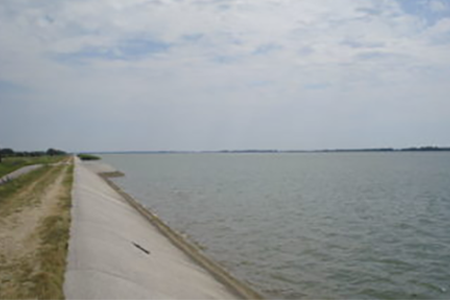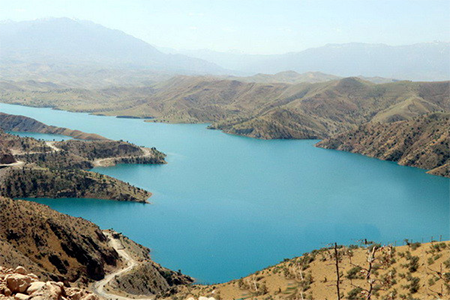
A lake is a hydrosphere component representing a naturally arisen water body filled with water within the boundaries of the so-called lake basin (lake bed); it has no direct connection to a sea (ocean). Lakes are objects of study by the science called limnology (lake hydrology).
From the standpoint of planetology, a lake is a steadily temporally and spatially existing object filled with a substance in liquid phase, the size of which is found in between the sea and pond. From the viewpoint of geography, a lake is a closed (inland) depression on the land surface where water flows down and accumulates. Lakes are not a part of the global ocean.
Although the chemical composition of lakes remains constant for a relatively long period, unlike rivers the medium filling lakes renews much more rarely, and streams in it are not a predominant factor that determines its regime. Lakes regulate river flows entrapping flood water in their structural basins and letting it flow in other periods. Chemical reactions take place in lake water. Some elements pass from water to bottom deposits, and the case with others is the reverse. In a number of lakes that mainly have no inflow salt concentration rises because of water evaporation. As a result, considerable changes in the lake salinity and salt composition take place. Due to substantial thermal inertia their water body, large lakes make the climate of the adjacent areas mild by reducing annual and seasonal fluctuations of atmospheric elements.
The shape, size, and configuration of lake basin beds notably change when bottom deposits accumulate. Lake overgrowth creates new forms of the configuration: flat or even dome shaped. Lakes and particularly water reservoirs often create groundwater dams that cause swamping of neighboring lands. Thick strata of bottom deposits are formed in lakes in the result of continuous accumulation of organic and mineral particles there. These deposits change with further development of water bodies and their transformation to swamps or dry lands. Under certain conditions, those turn into organic rock formations (organolites).
Types of lakes
According to their origin, there are the following types of lakes:
• Rift lakes: form as a result of subsidence along a geological fault in the Earth's tectonic plates;
• Glacial lakes: form from in a melted glacier;
• River-formed lakes (or oxbow lakes);
• Seashore lakes (lagoons or liman/coastal lakes);
• Plunge-basin lakes (karst lakes, thermokarst lakes). A feature of some plunge-basin lakes is their periodic disappearance and appearance depending on a unique groundwater dynamics;
• Landslide-barrier lakes: form in the result of a partial rockslide;
• Mountain lakes: located in mountain basins;
• Crater lakes: located in the craters of extinct volcanoes and diatremes;
• Artificial lakes (reservoirs, ponds): creation of such lakes may be an end in itself, for example for making water reservoirs for different purposes. Quite often creation of an artificial lake is to do with the conduction of more or less considerable amount of excavation works. However in some cases this type of lakes emerges as an incidental consequence of such works, for example in mined-out quarries.
According to their location, lakes are divided as follows:
• Surface lakes the water of which takes active part in the water cycle in nature, and
• Underground lakes the water of which even if participates in the water cycle, it does indirectly. Sometimes these lakes are filled with juvenile water.
According to their balance, lakes are broken down into the following categories:
• Drain-type (mainly inflows are represented by rivers);
• Closed/inland lakes (with no surface flow or underground water diversion to neighboring catchment areas; water consumption takes place due to evaporation).
According to their salinity, lakes are divided into the following types:
• Freshwater lakes;
• sweetwater lakes;
• Mineral (saline) lakea;
• brackish water lakes;
• saline water lakes;
According to their chemical composition, mineral lakes are broken down as follows:
• Carbonate (soda) lakes;
• Sulphate (bitter) lakes;
• Chloride (saline) lakes.
There are three types of lakes depending on the nutrient value (trophicity) of the matters contained in those:
• Oligotrophic (with small quantity of nutrients) lakes are characterized by commonly deep or mid depth; considerable volume of water below thermocline; high transparency; water color is from blue to green; gradual declining oxygen concentration towards the bottom close to which oxygen concentration in the water is high (at least 60% of the oxygen concentration at the surface).
• Eutrophic (with high content of nutrients) lakes are well warmed ones (the layer below thermocline is very thin); lower transparency; water color is from green to brown; the bottom is covered with organic silt (sapropelite). The water is rich in nutrient salts; oxygen concentration sharply decreases towards the bottom where it often totally disappears.
• Dystrophic (poor in nutrients) lakes are bog ones with low transparency and yellow or brown (because of high humic matter content) color of water; water salinity is low; ohygen concentration is low because of its consumption for oxidation of organic matters.
In modern hydrology and hydroecology, the following intermediate levels of trophic classification stand out: mesotrophic (intermediate between oligotrophic and eutrophic) and hypertrophic.
A pond is a body of standing water, either natural or man-made, that is usually smaller than a lake. They may arise naturally in floodplains as part of a river system, or they may be somewhat isolated depressions (examples include vernal pools and prairie potholes). Usually they contain shallow water with marsh and aquatic plants and animals. A few animals also make ponds, including both alligators and beavers. The type of life in a pond is generally determined by a combination of factors including water level regime (particularly depth and duration of flooding) and nutrient levels, but other factors may also be important, including presence or absence of shading by trees, presence or absence of streams, effects of grazing animals, and salinity.
Humans also make ponds. A wide variety of man-made bodies of water are classified as ponds. Some ponds are created specifically for habitat restoration, including water treatment. Others, like water gardens, water features and koi ponds are designed for aesthetic ornamentation as landscape or architectural features. Fish ponds are designed for commercial fish breeding, and solar ponds designed to store thermal energy.
Standing bodies of water such as puddles, ponds, and lakes are often categorized separately from flowing water courses, such as a brook, creek, stream or river.
The technical distinction between a pond and a lake has not been universally standardized. Limnologists and freshwater biologists have proposed formal definitions for pond, in part to include 'bodies of water where light penetrates to the bottom of the waterbody,' 'bodies of water shallow enough for rooted water plants to grow throughout,' and 'bodies of water which lack wave action on the shoreline.' Each of these definitions has met with resistance or disapproval, as the defining characteristics are each difficult to measure or verify. Accordingly, some organizations and researchers have settled on technical definitions of pond and lake which rely on size alone.
Even among organizations and researchers who distinguish lakes from ponds by size alone, there is no universally recognised standard for the maximum size of a pond. The international Ramsar wetland convention sets the upper limit for pond size as 8 hectares (20 acres), but biologists have not universally adopted this convention. Researchers for the British charity Pond Conservation have defined a pond to be 'a man-made or natural waterbody which is between 1 m2 and 20,000 m2 in area (2 ha or ~5 acres), which holds water for four months of the year or more.' Other European biologists have set the upper size limit at 5 ha (12 acres).
In practice, a body of water is called a pond or a lake on an individual basis, as conventions change from place to place and over time.


Monographs and brochures
Iljin, I.A. Water resources of the Fergana Valley [in Russian] (1959) 
Rivers and lakes of Tajikistan [in Russian] (2003) 
Stekolnikov, M.A. Water resources of Central Asia and Kazakhstan [in Russian] (1934) 
UNECE - First Assessment of Transboundary Rivers, Lakes and Groundwaters in the UNECE region (2007) 
UNECE - Second Assessment of transboundary rivers, lakes and groundwaters (2011) 
Papers